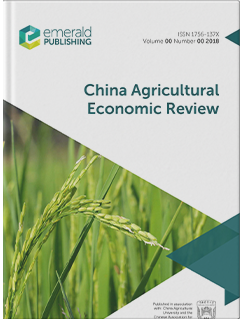Are there dynamic productivity gains from agricultural trade?
IF 4.6
2区 经济学
Q1 AGRICULTURAL ECONOMICS & POLICY
引用次数: 2
Abstract
PurposeThe primary purpose of this paper is to take an in-depth look at the question of whether liberalizing trade in agriculture can generate dynamic productivity gains comparable to those in the manufacturing sector.Design/methodology/approachIn contrast to the manufacturing sector that has generated firm/plant-level trade data, there is a lack of farm-level trade data that are needed for empirical measurement of dynamic productivity gains. Therefore, the authors use thought experiments to analyze the sequence of events that would occur when trade is liberalized for agriculture; delineate the expected behaviors of the actors involved in the trade and draw inferences about whether there would be dynamic productivity gains from agricultural trade.FindingsThe central finding is that there would be little dynamic gain from agricultural trade at the farm level due to the limited role of producers in shaping their international competitiveness. Yet, agricultural trade may generate dynamic gains if states or input supply corporations respond to the freer trade environment by making more investments for research and development (R&D). Further, when intraindustry prevails, there can be productivity gains at the industry level due to the transfer of resources from less to more efficient farm producers.Originality/valueThe findings of the paper are expected to present insights into value for researchers working in the area of agricultural trade; for agricultural trade policymakers in developing countries and for trade negotiators engaged in reforming or designing World Trade Organization (WTO)’s trade rules for agriculture.农业贸易是否带来了动态的生产力增长?
目的本文的主要目的是深入研究农业贸易自由化是否能产生与制造业相当的动态生产力增长的问题。设计/方法/方法与产生企业/工厂层面贸易数据的制造业相比,缺乏对动态生产力增长进行实证测量所需的农场层面贸易数据。因此,作者使用思维实验来分析当农业贸易自由化时会发生的一系列事件;描绘贸易参与者的预期行为,并推断农业贸易是否会带来动态的生产力增长。发现核心发现是,由于生产者在塑造其国际竞争力方面的作用有限,农业贸易在农场层面的动态收益很小。然而,如果各州或投入品供应公司对更自由的贸易环境做出反应,为研发进行更多投资,农业贸易可能会产生动态收益。此外,当行业内部盛行时,由于资源从效率较低的农业生产者转移到效率较高的农业生产者,行业一级的生产力可能会提高。原创性/价值该论文的研究结果有望为农业贸易领域的研究人员提供价值见解;为发展中国家的农业贸易政策制定者和参与改革或设计世界贸易组织(世贸组织)农业贸易规则的贸易谈判代表。
本文章由计算机程序翻译,如有差异,请以英文原文为准。
求助全文
约1分钟内获得全文
求助全文
来源期刊

China Agricultural Economic Review
AGRICULTURAL ECONOMICS & POLICY-
CiteScore
9.80
自引率
5.90%
发文量
41
审稿时长
>12 weeks
期刊介绍:
Published in association with China Agricultural University and the Chinese Association for Agricultural Economics, China Agricultural Economic Review publishes academic writings by international scholars, and particularly encourages empirical work that can be replicated and extended by others; and research articles that employ econometric and statistical hypothesis testing, optimization and simulation models. The journal aims to publish research which can be applied to China’s agricultural and rural policy-making process, the development of the agricultural economics discipline and to developing countries hoping to learn from China’s agricultural and rural development.
 求助内容:
求助内容: 应助结果提醒方式:
应助结果提醒方式:


